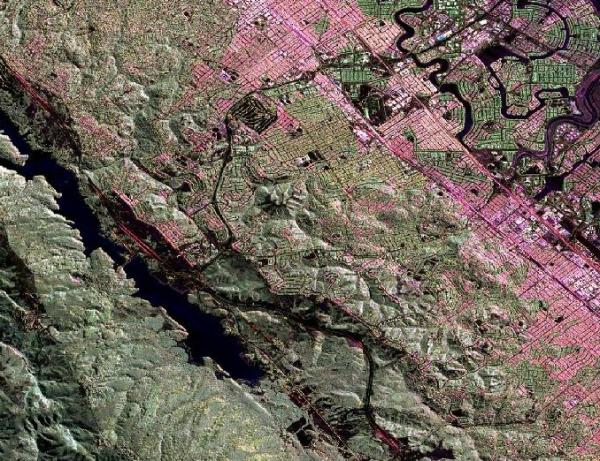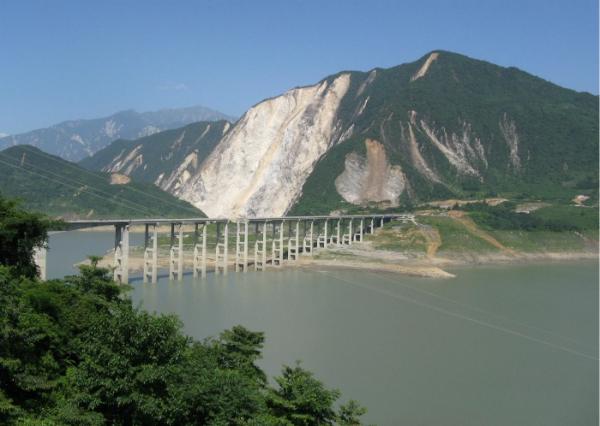
Earthmovers: How Human Interference Can Cause Earthquakes

A manmade doomsday machine capable of producing deadly earthquakes is the stuff of a supervillain's dreams, but it turns out that such powers aren't so far removed from reality.
Humans, by way of vast construction projects, are indeed capable of causing earthquakes a power that has proved a challenge to both understand and control.
Dams and the large reservoirs that pool behind them are one proven culprit behind manmade earthquakes the relationship between the weighty pools of water and seismic activity was established in the early 1940s, following the construction of the Hoover Dam.
Recently, a California scientist set out to see if a local reservoir might pose any danger. To the alarmist, this particular reservoir might appear uniquely positioned to do so.
China to California
The Anderson Reservoir lies atop the Calaveras fault, a major leg of the San Andreas Fault system. "In terms of day-to-day microactivity, it's the most active fault in the San Francisco Bay area," said Tom Parsons, a research geophysicist with the U.S. Geological Survey.
Although his findings were recently published in the journal Lithosphere, Parsons began his research on the reservoir in the fault's backyard many months ago, inspired by a cataclysm thousands of miles away.
Sign up for the Live Science daily newsletter now
Get the world’s most fascinating discoveries delivered straight to your inbox.
"There was a lot of talk at the time because of the China earthquake," Parsons told OurAmazingPlanet.
Some initially blamed China's devastating 2008 Wenchuan earthquake on a reservoir at the Zipingpu Dam, which lies roughly 3.5 miles (5.5 kilometers) from the quake's epicenter the spot where the rupture originated. The magnitude 7.9 earthquake left 87,587 people dead or reported missing and injured more than 374,000.

It turned out that the Anderson reservoir is comparable in size to the reservoir in China near the Wenchuan fault. Parsons said he expected to find at least some kind of correlation between the annual changes in the Anderson Reservoir's water levels, which change its weight, and seismic activity along the Calaveras fault.
Parsons got hold of roughly 25 years of water level data for the reservoir, beginning in 1980, and built a model that mapped how the changing weight would stress the underlying fault.
Parsons said he was a little surprised by his results. "I expected to see something," he said. "I expected this reservoir on the Calaveras was bad news."
Instead, Parsons found that the changing weight and resulting stress from the reservoir didn't appear to be at all related to the relatively small earthquakes that regularly rupture the Calaveras fault.
"I was surprised you could put that kind of loading on a fault and the fault wouldn't care," he said.
Under (water) pressure
Others were not so surprised.
"It's been there since the 1950s and it hasn't done anything, so I wouldn't worry about it," said Pradeep Talwani, an emeritus professor of geophysics at the University of South Carolina, backing up Parsons' findings that the Anderson Reservoir likely poses no danger.
Talwani spent more than three decades studying reservoir-induced earthquakes. He said that when reservoirs starts moving the Earth around, there are several factors at work: the weight of the water, how quickly the water levels in the reservoir fluctuate and the hydrological properties of the rock beneath. [Infographic: Tallest Mountain to Deepest Ocean Trench ]
In layman's terms, that means how easily water can seep down through cracks in the rock and reach a fault below. If a channel of water, snaking kilometers down into the Earth, reaches the fault, then big changes in the reservoir will affect the fault. The water allows the two ends (reservoir and fault) to talk to each other, allowing energy to travel from the surface down to the fault, and moving it in sometimes dangerous ways.
One way to picture the process is to imagine a plunger over a clogged sink. If you bounce the plunger up and down, it quickly changes the pressure pressing down on a clog, and eventually moves it.
Vast changes in reservoir levels affect faults in a similar way, but through water pressure instead of air pressure, and on a much longer timescale. Talwani pointed to the world's most infamous example a reservoir in Koyna, India, where water levels annually fluctuate by a whopping 130 feet (40 meters) within just a few months.
That reservoir caused a magnitude 6.3 earthquake in 1967 that killed 177 people, injured 2,000, and left more than 50,000 people homeless. Talwani said the reservoir has been causing earthquakes ever since. "That's the only example in the world where you have earthquakes ongoing," he said, adding that, despite a spate of other reservoir-caused earthquakes in the 1960s in Greece, China and Zimbabwe, reservoirs only very rarely spark large and dangerous earthquakes.
China dam to blame?
Talwani said he believes subsequent research has absolved China's Zipingpu reservoir of any responsibility in the devastating May 2008 quake that took so many lives.
Parsons himself said it's not clear where the blame lies, but said no reservoir could be the sole cause of such a large earthquake .
"The real causes are the Indian subcontinent crashing into Asia ," Parsons said. "A reservoir isn't going to start or stop that. At most it might have hastened it a year or two but certainly it didn't cause it."
In fact, Parsons said, there could be an ironic twist to come out of his research on the Anderson Reservoir and earthquakes.
"We may find that, paradoxically, it's more safe to build [reservoirs] where there are lots of earthquakes," Parsons said.
Although he said he was moving into the territory of pure speculation, Parsons said it was interesting to think that in seismically active areas, millennia of tectonic lurching may have collapsed fissures and holes lurking inside the Earth, akin to the way cereal might settle inside a box during shipping, making it more difficult for reservoir water to reach a fault.
Parsons said after doing his research, he did feel comfortable saying the following with scientific certainty: "It's not idiotic to build a reservoir near a major fault zone. I think it's not saying that it's safe to do this everywhere," he said," but it's saying it's not absolutely certain that if you do, you'll trigger an earthquake."
- Image Gallery: This Millennium's Destructive Earthquakes
- The 7 Most Dangerous Places on Earth
- The 10 Biggest Earthquakes in History
Reach Andrea Mustain at amustain@techmedianetwork.com. Follow her on Twitter @AndreaMustain.









